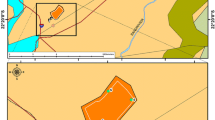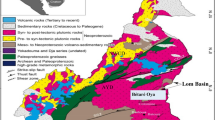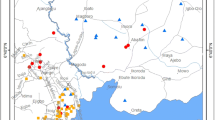Abstract
The basin of Moulouya Oued is a region where mining industry has been developed early in the 20th century. As a consequence, residues generated from past mining activities over the years have been dumped as piles of tailings. Zaïda is one of the most affected region in this basin because of lead mine exploitation for long time. The aim of this study is to determine the amount of trace elements and the contamination of the river sediments. Analysis of collected samples has been achieved using the prompt gamma activation analysis method. The samples, in form of powders, were enclosed in Teflon sheets. The spectra were analyzed using HYPERMET PC software and the chemical composition is calculated using an Excel-macro that provides the concentrations as molar and weight percentages, as well as the corresponding masses of the oxides. The validation of the analytical method is demonstrated with the analysis of a reference material. The results show that the distribution of the studied metals (Pb, Zn, Cu, Cd, Cr Ni, and As) in the basin is dependent on location with a very significant contamination by Pb, Zn, Cu, Cd, Cr, and Ni close to the lead mine sites.





Similar content being viewed by others
References
Couillard D, Chartier M, Mercier G (1994) Etude de l’enlèvement du Cd, Cu, Mn et Zn par solubilisation biologique fortement contaminés. Rev des Sci de l’Eau 7:251–268
Tessier A, Campbell PGC, Bisson M (1980) Trace metal speciation in the Yamaska and St Francois Rivers (Quebec). Can J Earth Sci 17:90–105
Luoma SN (1989) Can we determine the biological availability of sediment-bound trace elements? Hydrobiologia 176(177):379–396
Wen X, Du Q, Tang H (1998) Surface complexation model for the heavy metal adsorption on natural sediment. Environ Sci Technol 32:870–875
Campbell PGC, Lewis AG, Chapman PM, Crowder AA, Feltcher NK, Imber B, Luoma SN, Stokes PM, Winfrey M (1988) Biologically available metals in sediments. NRCC 27694. National research Council of Canada, Ottawa, p 298
Shea D (1988) Developing national sediment quality criteria. Environ Sci Technol 22:1261–1656
Couillard D (1987) Qualité des sédiments en suspension et fond du système Saint-Laurent (Canada). J Hydrol Sci 32:445–467
Lee CG, Chon HT, Jung MC (2001) Heavy metal contamination in the vicinity of the Daduk Au-Ag-Pb-Zn mine in Korea. Appl Geochem J 16:1377–1386
Thomas JFA (1980) Soil contamination at Shipham-report on studies completed in the village and advice to residents. Ministry of Agriculture, Fisheries and Food, London
Matthews H (1982) The distribution of cadmium and associated elements in the soil-plant system at sites in Britain contaminated by mining, smelting and metal-rich bedrock. PhD Thesis. University of London
Saidi N (2004) Le bassin versant de la Moulouya: pollution par les métaux lourds et essais de phytoremédiation. PhD Thesis. Faculty of Sciences, University Mohamed V, Rabat, Morocco
Thornton I (1980) Geochemical aspects of heavy metal pollution and agriculture in England and Wales. Reference Book, Ministry of Agriculture, Fisheries and Food No. 326 pp 105–125
Li X, Thornton I (1993) Multi-element contamination of soils and plants in old mining areas, U.K. Appl Geochem (suppl no. 2):51–56
Jung MC, Thornton I (1996) Heavy metal contamination of soils and plants in the vicinity of a lead-zinc mine, Korea. Appl Geochem 11:53–59
Benisse R, Labat M, El Asli A, Bahada F, Qatibi A (2004) Rhizosphere bacterial populations of metallophyte plants in heavy metal-contaminated soils from mining areas in semiarid climate. World J Microbiol Biotechnol 20:759–766
Ye ZH, Baker AJM, Willis AJ (1997) Zinc, lead and cadmium tolerance, uptake and accumulation by Typha latifolia. New Phytol 136:469–480
Fuge R, Pearce FM, Pearce NJG, Perkins WT (1993) Geochemistry of Cd in the secondary environment near abandoned metalliferous mines. Appl Geochem 2:29–35
Dudka S, Piotrowska M, Chlopeckca A, Witek T (1995) Trace metal contamination of soils and crops plants by the mining and industry in Upper Silesia, south Poland. J Geochem Explor 5:237–250
Jung MC (2001) Heavy metal contamination of soils and waters in and around the Imcheon Au–Ag mine, Korea. Appl Geochem 16:1369–1375
Bouabdli A, Saidi N, El Founti L, Leblanc M (2004) Impact de la mine d’Aouli sur les eaux et les sédiments de l’Oued Moulouya (Maroc). Bull de la Société D’hist Naturelle de Toulouse 140:27–33
El Hachimi M (2007) Les districts miniers Aouali-Mibladen-Zaïda, abandonnés dans la Haute Moulouya (Maroc). Ph D Thesis. Faculty of Sciences, University Ibn Tofaïl, Kenitra
Zs Révay (2009) Determining elemental composition using prompt γ activation analysis. Anal Chem 81:6851–6859
Révay Zs, Belgya T, Ember PP, Molnár GL (2001) Recent developments in HYP ERMET PC. J Radioanal Nucl Chem 248(2):401–405
Révay Zs, Firestone RB, Belgya T, Molnár GL (2004) Handbook of prompt gamma activation analysis with neutron beams. Kluwer Academic Publishers, Dordrecht, pp 173–366
Bowen HJM (1979) Environmental chemistry of elements. Academic Press, New York, pp 49–62
Smedley PL, Kinniburgh DG (2002) A review of the source, behaviour and distribution of arsenic in natural waters. Appl Geochem 17:517–568
HSDB (2003) National library of medicine. htpp://www.toxnet.nlm.nih.gov
CE (1999) Risk assessment for zinc metal. Part 2: human health. European Commission, Brussels
CE (2000) European Union, RB26005 env
Molénat N, Holeman M, Pinel R (2000) L’arsenic, polluant de l’environnement: origine, distribution, biotransformation. L’Actual Chim 232:12–23
Boust D (1981) Métaux traces dans l’estuaire de la seine et ses abords. Thèse de 3ème cycle. Caen University, Caen, p 187
Author information
Authors and Affiliations
Corresponding author
Rights and permissions
About this article
Cite this article
Bounakhla, M., Embarch, K., Tahri, M. et al. PGAA metals analysis in tailings in Zaida abandoned mine, high Moulouya, Morocco. J Radioanal Nucl Chem 291, 129–135 (2012). https://doi.org/10.1007/s10967-011-1321-6
Received:
Published:
Issue Date:
DOI: https://doi.org/10.1007/s10967-011-1321-6




